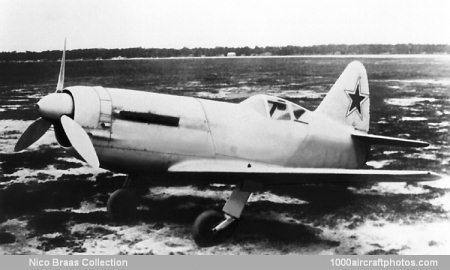Arkhip Lyul'ka was in fact testing his VRD-2 turbojet, but it was nowhere near ready for use. The only available kind of jet power plant was the VRDK, translated as air reaction auxiliary compressor. Developed since 1942 at the Central Institute of Aviation Motors by a team led by K.V. Kholshchevnikov, it comprised a conventional piston engine and propeller plus a shaft-driven auxiliary compressor, combustion chamber and jet pipe. Thus, an aircraft fitted with it was basically a traditional fighter, but with an additional jet boost system.
The engine was a Klimov VK-107R. This was basically a VK-107A, rated at 1,650 hp for take off and at 1,450 hp at l2,470 ft (3,800 m), but fitted with an auxiliary drive. At take off more than 95% of the power was transmitted by the engine's reduction gear to the 10 ft 2 in (3.1 m) AV-5B propeller. For a dash at maximum speed a clutch behind the crankshaft was engaged, driving a step-up gearbox (l3:21 ratio) to a shaft which drove the auxiliary axial compressor in a large duct along the lower part of the fuselage. Air flowed through this duct at all times, from an inlet under the spinner, to cool the main radiator which was just behind the compressor. From the top of the duct a secondary pipe led to the supercharger on the engine. With the compressor under power the flow was greatly enhanced, the greater pressure in the secondary upper pipe serving to boost the output of the engine.
To energize flow through the main duct still further, petrol was sprayed from seven nozzles downstream of the radiator and ignited by sparking plugs. From this point the duct expanded to form a combustion chamber, its material changing from aluminum to welded stainless steel. Water from a 17 gal (78 l) tank was sprayed over the duct to reduce wall temperature and protect the fuselage, the steam adding to the propulsive thrust. The high-velocity jet escaped through hydraulically controlled nozzle eyelids, which in cruising flight could cover over the nozzle to reduce base drag.
The whole system was clumsy, but in the absence of a turbojet an impressive achievement. At 22,966 ft (7,000 m) it was estimated to have an equivalent power of 2,500 hp, of which 1,350 came from the auxiliary duct system. The VRDK had been extensively tested on the ground, but could not be flight tested until a fighter could be completed. In the event, the Mikoyan and Gurevich example, know as aircraft N, was ready first.
Aircraft N was of entirely stressed-skin construction, with no wood and with welded steel tubing restricted to the cradle carrying the engine.
The wing had a 10% CAHI (Central Aerodynamics and Hydrodynamics Institute) laminar airfoil, with two spars and plate ribs. CAHI slotted flaps were fitted, and two-section Frise-type ailerons outboard, but no slats. The fuselage comprised the engine compartment with removable cowl panels, the mid-section including the cockpit, and the short tail section to which was attached the removable tail unit. Because of the VRDK duct it looked exceptionally deep. Air rammed in around the top and sides of the spinner, passed through the oil cooler around the propeller gearbox, exiting through controllable gills round the top of the cowling. Fuel was housed in an 110 gal (415 l) fuselage tank and two 26.5 gal (100 l) wing tanks, all of self-sealing rubberized fabric.
The main landing gear was most unusual in that the levered-suspension arms carrying the wheels were ahead of the legs. The bay doors were claimed by Mikoyan to be the first in the USSR to be closed at all times except when the gear was actually cycling up or down. Track was 9 ft 0.25 in (2.75 m) and wheel base 16 ft 4.67 in (4.995 m). The small castoring tail wheel retracted into a fairing under the jet nozzle. Because of the big tank on the center of gravity the cockpit reverted to its location in the first MiG fighters, behind the wing. The simple tail was entirely of stressed-skin construction, the port elevator having a trim tab.
A detailed mockup was approved on October 26, 1944. The white painted prototype, called the N No. 1 (and designated I-225 by the NKAP (state commissariat for aviation industry) was rolled out on 26 February 1945. It was fully armed, with three Sh VAK B-20 (not G-20) 0.787 in (20 mm) cannon, one firing through the propeller hub and the others beside the crankcase. Each magazine was from the outset designed to accommodate 160 rounds.
OKB pilot A.P. Deyev made the first flight on March 3, 1945. The AV-5L was the standard VK-107 propeller used with success on many other aircraft. With the VRDK in operation the aircraft was extremely noisy, but said to be 62 mph (100 kmh) faster than other piston-engined fighters. In mid-May Deyev pulled excessive g and was killed following tail plane failure.
The second prototype, N No. 2, flew in late May. It was painted dark blue, with a yellow horizontal streak, and at first had no guns fitted. LII (flight research institute) pilot A.P. Yakimov was later assisted by OKB pilots A.N. Chernoburov and I.T. Ivashchenko. It was soon established that directional stability was inadequate, and the leading edge of the fin was reconstructed to increase chord. The tail wheel strut was redesigned, eliminating the need for the ventral fairing. This aircraft was damaged beyond repair in a crash landing by Chernoburov.
In June 1945 the OKB embarked on a crash program to build ten aircraft for a flypast over Red Square on October Revolution day (November 7). The aircraft were built, and made deafening low-level practice runs with VRDK, but the actual air parade was cancelled by bad weather.
In the performance figures here, the use of VRDK is assumed. It was normally restricted to periods totaling ten minutes in any flight.
